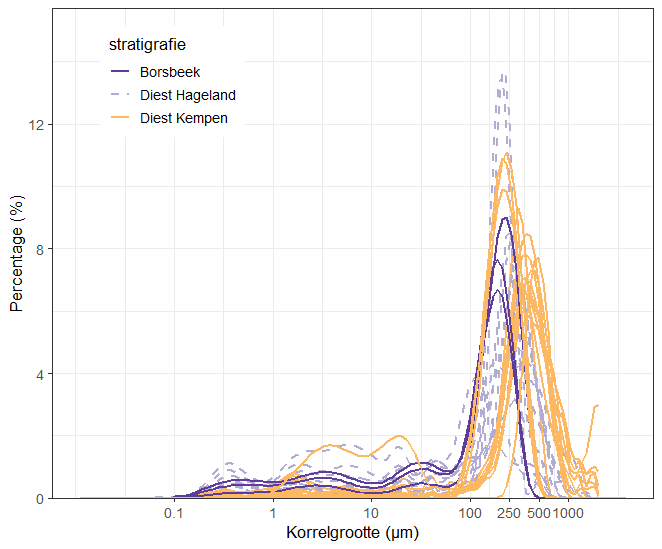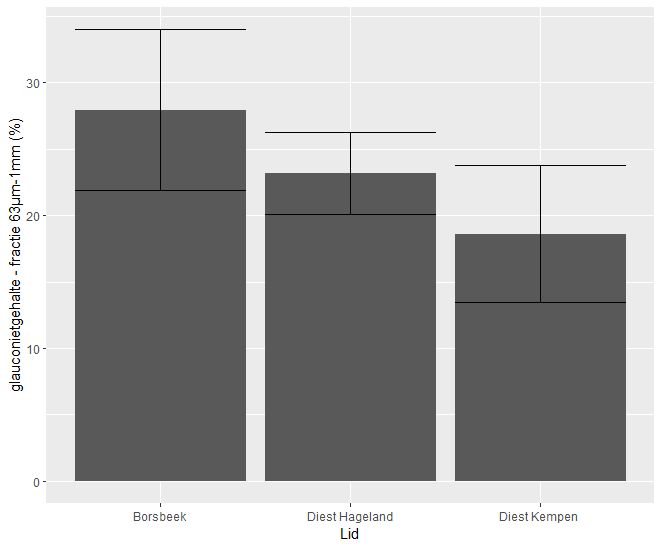Diest Formatie
Deze pagina moet gelezen worden in de context van de pagina rond het 'geologisch paspoort van de Vlaamse ondergrond'.
Data op deze pagina worden aangevuld wanneer binnen dit project nieuwe analyses uitgevoerd worden. Op DOV en in de literatuur zijn ook nog veel andere data te vinden die niet op deze pagina verwerkt zijn.
Formele stratigrafische definitie - Nationale Stratigrafische Commissie
Referentiesecties
Tijdelijke ontsluitingen
Data
Van de Formatie van Diest werden 29 stalen geanalyseerd voor korrelgrootte, van het Kempen Diest Lid (14 stalen), het Hageland Diest Lid (12 stalen) en het Borsbeek Lid (3 stalen) (Verhaegen & De Nil, 2024). De Diest Formatie bestaat uit gemiddeld tot grof slecht tot matig gesorteerd zand met een onderverdeling tussen het Deurne Lid en Borsbeek Lid in de Antwerpse regio en het Dessel Lid, Kempen Diest Lid en het Hageland Diest Lid in het zuiden (Houthuys et al., 2020).


De stalen van het Hageland Diest Lid geanalyseerd in deze studie hebben de fijnste korrelgrootte en het hoogste kleigehalte van beide onderzochte eenheden van de Diest Formatie, met een mode van 245 ± 79 µm en een d10 van 28 ± 50 µm. De stalen van het Kempen Diest Lid tonen een matig goed gesorteerd en beduidend grover gemiddeld zand met een mode van 317 ± 115 µm en een d10 van 118 ± 102 µm. (Figuur 1; Tabel 1). De stalen van het Kempen Diest Zand tot dusver geanalyseerd zijn hoofdzakelijk afkomstig van het zuidelijke voorkomensgebied nabij de grens met het Hageland Diest Lid. De stalen van het Borsbeek Lid hebben de fijnste korrelgrootte met een mode van 195 ± 19 µm en een d10 van 6,7 ± 8,7 µm.


Het glauconietgehalte gemeten voor de stalen van het Kempen Diest lid (19 ± 16 %) is beduidend lager dan de waardes gekend uit de literatuur voor de Diest Formatie (gemiddeld 35 à 40 %; Houthuys et al., 2020). Het gemiddelde wordt naar beneden gehaald door de stalen van Ham en Meerhout waar het glauconiet gehalte lager is dan 10 %. In het staal van Heist-op-den-Berg bedraagt dit 50 % in de fractie 63 µm-1 mm en in de stalen uit Ranst is dit 20 à 30 %. Ook voor het Hageland Diest lid zijn de gemeten waarden eerder laag (23 ± 9 %) (Figuur 2). De stalen van het Borsbeek Lid hebben een glauconietgehalte van 28 ± 10 %.
Het kalkgehalte werd niet gemeten omdat de Diest Formatie, m.u.v. het Borsbeek Lid, Deurne Lid en de basis van het Dessel Lid, ontkalkt is.
Links naar andere grote open source databronnen
- Adriaens, R. 2015. PhD thesis (en afgeleide publicaties, zie referentielijst):
(klei)mineralogie, korrelgrootte, glauconietgehalte
- Verhaegen, J. 2019. PhD thesis (en afgeleide publicaties, zie referentielijst):
zware mineralen, korrelgrootte, chemie, zirkoon U/Pb geochronologie
Sleutelreferenties
Adriaens, R., 2015. Neogene and Quaternary clay minerals in the southern North Sea. Unpublished Ph.D. Thesis, KU Leuven, Leuven, 272 p.
Adriaens, R. & Vandenberghe, N., 2020. Quantitative clay mineralogy as a tool for lithostratigraphy of Neogene Formations in Belgium: a reconnaissance study. Geologica Belgica 23/3-4, 365-378. https://doi.org/10.20341/gb.2020.018
Bosselaers, M., Herman, J., Hoedemakers, K., Lambert, O., Marquet, R. & Wouters, K., 2004. Geology and palaeontology of a temporary exposure of the Late Miocene Deurne Sand Member in Antwerpen (N. Belgium). Geologica Belgica, 7/1-2, 27–39.
De Batist, M. & Versteeg, W.H., 1998. Seismic stratigraphy of the Mesozoic and Cenozoic in northern Belgium: main results of a high-resolution reflection seismic survey along rivers and canals. Geologie en Mijnbouw, 77, 17–37. https://doi.org/10.1023/A:1003446611678
Deckers, J. & Louwye, S., 2020. The architecture of the Kattendijk Formation and the implications on the early Pliocene depositional evolution of the southern margin of the North Sea Basin. Geologica Belgica, 23/3-4, 323- 331. https://doi.org/10.20341/gb.2020.017
De Meuter, F., 1974. Bijdrage tot de systematiek en de paleoecologie van de benthonische foraminiferen uit het Mioceen van België. Unpublished Ph.D. Thesis, Katholieke Universiteit Leuven, Leuven, Part I, 30 p.
De Meuter, F., 1980. Benthonic Foraminifera from the Miocene of Belgium. Aardkundige Mededelingen, 1, 78–169.
De Meuter, F.J.C. & Laga, P.G.H., 1970. Coiling ratios and other variations of Globigerina pachyderma (Ehrenberg, 1861) and the stratigraphic significance in the Neogene deposits of the Antwerpen area, Belgium. Bulletin de la Société belge de Géologie, de Paléontologie et d’Hydrologie, 79/2, 175–184.
De Meuter, F. & Laga, P., 1976. Lithostratigraphy and biostratigraphy based on benthonic foraminifera of the Neogene deposits in Northern Belgium. Bulletin Belgische Vereniging voor Geologie/Bulletin de la Société belge de Géologie, 85, 133–152.
De Meuter, F.J., Laga, P.G., Ringelé, A. & Roose, V., 1967. Compte rendu de l’excursion du samedi 29 octobre 1966, faite à Deurne, près d’Anvers. Bulletin de la Société belge de Géologie, de Paléontologie et d’Hydrologie, 75, 392–394.
De Meuter, F., Wouters, K. & Ringelé, D., 1976. Lithostratigraphy of Miocene sediments from temporary outcrops in the Antwerp city area: Pl. Antwerpen 28 W, Pl. Borgerhout 28 E. Service Géologique de Belgique, Professional Paper, 1976/3, 19 p.
de Verteuil, L. & Norris, G., 1996. Miocene dinoflagellate stratigraphy and systematics of Maryland and Virginia. Micropaleontology, 42, Supplement, 1–172. https://doi.org/10.2307/1485926
Dumont, A., 1839. Rapport sur les travaux de la carte géologique pendant l'année 1839. Bulletins de l’Académie royale des Sciences et Belles-Lettres de Bruxelles, 6/2, 464–485.
Dybkjær, K. & Piasecki, S., 2010. Neogene dinocyst zonation for the eastern North Sea Basin, Denmark. Review of Palaeobotany and Palynology, 161/1-2, 1–29. https://doi.org/10.1016/j.revpalbo.2010.02.005
Glibert, M. & de Heinzelin de Braucourt, J., 1955a. La faune et l’âge Miocène supérieur des Sables de Deurne : I. Descriptions. Bulletin de l’Institut royal des Sciences naturelles de Belgique, 30/71, 1–27.
Glibert, M. & de Heinzelin de Braucourt, J., 1955b. La faune et l’âge Miocène supérieur des Sables de Deurne : II. Conclusions. Bulletin de l’Institut royal des Sciences naturelles de Belgique, 31/72, 1–12.
Goolaerts, S., De Ceuster, J., Mollen, F.H., Gijsen, B., Bosselaers, M., Lambert, O., Uchman, A., Van Herck, M., Adriaens, R., Houthuys, R., Louwye, S., Bruneel, Y., Elsen, J. & Hoedemakers, K., 2020. The upper Miocene Deurne Member of the Diest Formation revisited: unexpected results from the study of a large temporary outcrop near Antwerpen International Airport, Belgium. Geologica Belgica, 23/3-4, 219-252. https://doi.org/10.20341/gb.2020.011
Hooyberghs, H.J.F. & Moorkens, T.L.A., 2005. Biostratigraphic study of the “Middelares Hospital” outcrop section in the Deurne Sand Member (Upper Miocene, Belgium) as based on foraminifera. Neues Jahrbuch für Geologie und Paläontologie, Abhandlungen, 237/1, 5–28. https://doi.org/10.1127/njgpa/237/2005/5
Gulinck, M., Geets, S. & Van Voorthuysen, J.H., 1963. Note sur les sondages du Centre Nucléaire à Mol. Bulletin de la Société belge de Géologie, 72, 283–294
Houthuys, R., Adriaens, R., Goolaerts, S., Laga, P., Louwye, S., Matthijs, J., Vandenberghe, N. & Verhaegen, J., 2020. The Diest Formation: a review of insights from the last decades. Geologica Belgica, 23/3-4, 199- 218. https://doi.org/10.20341/gb.2020.012
King, C., 1983. Cainozoic Micropalaeontological Biostratigraphy of the North Sea. Report of the Institute of Geological Sciences, 82/7, 40 p.
King, C., 2016. A revised correlation of Tertiary rocks in the British Isles and adjacent areas of NW Europe. Gale, A.S. & Barry, T.L. (eds). Geological Society, London, Special Reports, 27, 1–719. https://doi.org/10.1144/SR27
Laga, P. & De Meuter, F., 1972. A foraminiferal fauna found in the lower Member of the Diest Formation of borings in the Antwerp Kempen (NE-Belgium). Bulletin de la Société belge de Géologie, 81, 211–220
Louwye, S., De Schepper, S., Laga, P., & Vandenberghe, N., 2007. The Upper Miocene of the southern North Sea Basin (northern Belgium): a palaeoenvironmental and stratigraphical reconstruction using dinoflagellate cysts. Geological Magazine, 144/1, 33–52. https://doi.org/10.1017/S0016756806002627
Louwye, S. & Vandenberghe, N., 2020. A reappraisal of the dinoflagellate cyst biostratigraphy of the upper Miocene in the Maaseik well 49W0220. Geologica Belgica, 23/3-4, 289-295. https://doi.org/10.20341/gb.2020.013
Mourlon, M., 1876. Sur les dépôts qui, aux environs d’Anvers, séparent les sables noirs miocènes des couches pliocènes scaldisiennes. Bulletin de l’Académie royale des Sciences, des Lettres et des Beaux-Arts de Belgique, 2 e série, 42, 760–790.
Munsterman, D.K., ten Veen, J.H., Menkovic, A., Deckers, J., Witmans, N., Verhaegen, J., Kerstholt-Boegehold, S.J., van de Ven, T., & Busschers, F.S., 2020. An updated and revised stratigraphic framework for the Miocene and earliest Pliocene strata of the Roer Valley Graben and adjacent blocks. Netherlands Journal of Geosciences, 98, e8. https://doi.org/10.1017/njg.2019.10
Spiegler, D., 2001. Bolboforma biostratigraphy in the Neogene glauconitic sands of Belgium. In Vandenberghe, N. (ed.), Contributions to the Paleogene and Neogene stratigraphy of the North Sea Basin. Aardkundige Mededelingen, 11, 61–68.
Vandenberghe, N., Harris, W.B., Wampler, J.M., Houthuys, R., Louwye, S., Adriaens, R., Vos, K., Lanckacker, T., Matthijs, J., Deckers, J., Verhaegen, J., Laga, P., Westerhoff, W. & Munsterman, D., 2014. The implications of K-Ar glauconite dating of the Diest Formation on the paleogeography of the Upper Miocene in Belgium. Geologica Belgica, 17, 161–174
Vandenberghe, N. & Louwye, S., 2020. An introduction to the Neogene stratigraphy of northern Belgium: present status. Geologica Belgica, 23/3-4, 97-112. https://doi.org/10.20341/gb.2020.008
Verhaegen, J. 2019. Quantitative sediment provenance and volumetric reconstruction - application to the Miocene of the southern North Sea Basin. PhD thesis, KU Leuven, 239p.
Verhaegen, J. 2020. Stratigraphic discriminatory potential of heavy mineral analysis for the Neogene sediments of Belgium. Geologica Belgica 23 (3-4), 379-398. https://doi.org/10.20341/gb.2020.003
Verhaegen, J., von Eynatten, H., Dunkl, I. & Weltje, G.J., 2021. Detrital zircon geochronology and heavy mineral analysis as complementary provenance tools in the presence of extensive weathering, reworking and recycling: the Neogene of the southern North Sea Basin. Geological Magazine, 158, 1572-1584. https://doi.org/10.1017/S0016756821000133
Willems, W., 1976. The genus Bolboforma Von Daniels & Spiegler in the Upper Miocene of northern Belgium. Bulletin de la Société belge de Géologie, 85/1, 31–38.
Wouters, L. & Schiltz, M., 2012. Overview of the field investigations in and around the nuclear site of Mol Dessel. ONDRAF/NIRAS NIROND-TR report 2011–42 E, 100 p.
